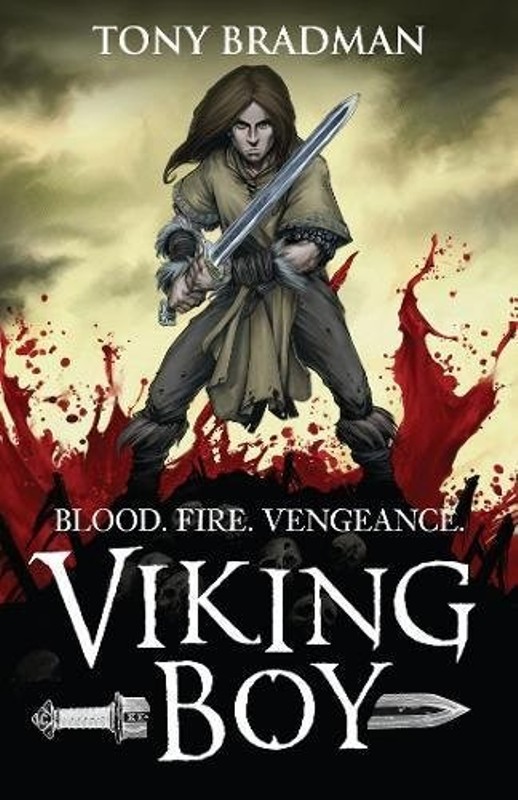
This article is in the Category
Just One Click Away from an Author
Tony Bradman discovers how using social media can help in the classroom.
My children’s novel, Viking Boy, was published in 2012 by Walker Books. It’s the story of Gunnar, a boy who has to flee his home after it’s burned down in a Viking raid, and includes all the things I thought should go into an adventure story set in the Viking age. There’s a legendary sword, a sea-journey in a dragon-powered Viking ship, some very cool Viking warriors (both good and evil), lots of fighting, Valkyries riding on winged wolves and even a couple of appearances from the chief of the Norse Gods, Odin himself.
It was a lot of fun to research and write, and it got some great reviews. I did my best to promote the book on social media – I’m a relentless Tweeter and do lots of posts on Facebook and Instagram. I was aware the National Curriculum says primary-aged children should study the Vikings, so I was hoping the book would find an audience in schools. I’ve done hundreds of school visits in my 30-plus years as a writer of children’s books, so I know that teachers often use fiction to support children’s work in certain subjects. I had a feeling Viking Boy might turn out to be useful in that respect.
The book sold well, and I always mentioned it in my school visits. But, as a professional writer, you have to move on to other projects and new books, so I put Viking Boy behind me and did just that. But then, out of the blue last year, a teacher called Andy Johnston tagged me in a tweet saying that his Year 5 class had been learning about the Vikings, and had really been enjoying Viking Boy. I’ve been tagged about other books in the past, and I always reply to say how pleased I am. But this time I did more than that – I offered to send the class some pictures of pages from the notebook I’d used when I was working on the story. These included lists of names for characters, research notes, outlines of the plot, early drafts and so on.
Andy took me up on my offer, and soon we were engaged in a lengthy electronic correspondence! He told me what the class thought, and tweeted pictures of the amazing work they were doing inspired by my book, tagging me in the process. I could then respond (and relentlessly retweet!), so I was able to tell the kids just how impressed I was. Eventually Andy did a detailed lesson plan based on Viking Boy, which helped the children do some even more amazing work. I’ve seen plenty of displays of work based on many of my other books when I’ve visited schools, but this was different, somehow. It felt instant and very direct – interactive for the kids, and for me.
That wasn’t the end of it, though. I soon discovered that lots of teachers use Twitter. Friends and followers of Andy quickly picked up on the Viking Boy tweets, which I’m sure led to some more sales of the book. But then other teachers tweeted to say they were using Viking Boy as well; I offered to send them pictures of my notebook too, but also suggested doing some short Skype sessions (usually half an hour or so) with their classes, and soon I found myself talking to children all over the country, answering their questions about the story, the Vikings, my other books with historical themes, my favourite authors…
I learned several lessons from all this. The first was that social media can really help to connect you with your readers. I began to realise that up until then I’d seen social media through an old-fashioned, analogue lens – I’d always thought of it as a form of advertising, a way of letting people know about my work. But this took promotion to a whole other level – I felt I was really connecting to my readers. That happens with school visits, of course, but that’s just on one day. Through social media, I was able to follow the way readers responded to my book and how they got value from it over quite a long period of time. I also saw their work in detail – I received lots of tweeted pictures of stories and pictures inspired by what I’d written.
Secondly, I realised that this kind of connection can be enormously useful for teachers and classes. Many children’s authors have Twitter accounts and use other forms of social media too. In fact, it’s almost compulsory these days – publishers are very keen for their authors to engage in this kind of online activity! You can almost guarantee that the author of the books you read to the children in your class is little more than a click away. Most authors love to hear from their readers, and I have a feeling that if you tweet to an author that your class is enjoying her book, you can almost guarantee a response of some kind. And if you’re lucky that author might, like me, offer you something more than just a reply.
 Tony Bradman has written many books for children of all ages. He is also chair of the Authors’ Licensing and Collecting Society (ALCS), Co-Chair of CLA, and Chair of The Siobhan Dowd Trust.
Tony Bradman has written many books for children of all ages. He is also chair of the Authors’ Licensing and Collecting Society (ALCS), Co-Chair of CLA, and Chair of The Siobhan Dowd Trust.
Viking Boy is published by Walker Books, (9781406313833) £6.99.





